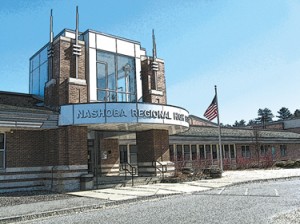By Ann Needle
Pressure is mounting for Nashoba Regional administrators to make a solid case for why (and how) the high school should be updated. At Thursday’s meeting of the Nashoba Regional Space Study Task Force, members also questioned whether the group would be ready to meet a state deadline to apply for funding of any renovations.
In looking over a working draft of a report that should define what NRHS needs, task force member Bob Czekanski of Bolton told Superintendent Michael Wood, “You’re implying that your facilities are overloaded, but there’s no indication why.” Czekanski maintained that such key figures as the percentage of people turned away from using a conference room, or how many students can fit into a classroom vs. how many need to, are still missing.
“We need to know what other schools have. What does [the state] recommend for space?” Czekanski said. ”How many kids are at the tutoring project in the Media Center at one time? What are the administrative and support requirements that aren’t being met?”
Wood has said that the report should comprehensively define NRHS’s space needs to the Nashoba School Committee. He also targeted finishing the report by January, in time to submit a statement of interest to the MA School Building Authority in applying for state funds for any proposed high school upgrades.
Full House Reported
In reviewing the report bullet points drafted so far, the Task Force worked to start outlining just why certain facets of the high school must be updated. Overall, the high school’s staff stressed that it has run out of instructional space.
NRHS Principal Dr. Parry Graham reported that the school is using almost 93 percent of its instructional space, though the MSBA recommends capping that at 85 percent. This means Nashoba is short about 7,575 square feet of classroom space by state standards, he added. Put another way, Graham noted that NRHS only has 33 of the 39 instructional classrooms the MSBA recommends for high schools of its size. He added that these numbers do not include computer or science labs.
Graham said that nine of the 10 Science classrooms are smaller than the 1,440 square feet the MSBA recommends, and none of the 10 Science lab prep rooms meets the state standard of 200 square feet. Teacher Martina Kenyon noted that, for two classes, there is only one ventilation hood for working with strong chemicals. If a class without the hood needs to work with these chemicals, she explained that the classes either need to switch with each other for the day, or the hood-less class needs to transport the chemicals, which is never an ideal situation.
In comparing NRHS with state standards, Graham outlined several more areas where Nashoba comes up short space-wise. Among these was Special Education, where Nashoba offers only four of the eight recommended classrooms, and one group work room instead of four. Michael Wood commented that there are no longer dedicated spaces for the occupational and physical therapists.
This lack of classroom space apparently has impacted other areas. In Guidance, not only does NRHS lack a dedicated career center, Graham said, but, “I walked through Guidance the other day, and there was a college representative meeting with four or five students — in front of the receptionist’s desk.” The cafeteria hosts four 22-minute lunches daily, rather than the state-recommended three lunches. Graham asserted that, during a recent lock-down drill, many students in the packed lunch room never heard the emergency announcement.
Meanwhile, with many more facets of the high school space yet to review, the Task Force expressed uncertainty over whether its report would be ready for the state’s January SOI deadline.
“My gut says we’re not going to be ready to do that; it’s still a long runway in front of us,” Czekanski said.
Though Wood conceded he also is concerned, he stressed that if Nashoba missed the deadline, it would likely need to wait another year until the state accepts SOIs once again. At this point, the Task Force agreed to leave mention of the possible SOI out of the report until it became clearer if it would be finished by January.
The next Task Force meeting is scheduled for October 16, 7p.m.